Review of the Sabrent Rocket PCIe 4.0 PCIe Gen 4 NVMe SSD
Of all the brands that have embraced the PCIe 4.0 M.2 NVMe SSD revolution, few have been as aggressive as Sabrent. In a little over 10 months, they not only released their first PCIe4 SSD, but then fleshed out an entire multi-tiered range of drives within this tier. Named the Sabrent Rocket Series, there is three individual tiers available in the Rocket 4 Plus Premium/Prosumer level, the Sabrent Rocket Q4 Home/Budget level and finally, right there in the middle, the Rocket PCIe 4.0 series. That last one is the focus of today’s review, as it is the one that promises a good balance of performance, capacity and price. Although the Sabrent Rocket PCIe 4.0 was the first of this series to arrive, it is still quite current in 2021, arriving with a market endorsed Phison controller, 96Layered NAND and a very unique build & presentation. Although, it might have been usurped by the Rocket 4 Plus in the eyes of prosumer/business buyers and the ever-changing pricing of SSDs (thanks to the ripples of the pandemic, chia, semiconductor shortages and the trade war), as well as newer and more powerful SSDs landing in summer 2021 in the Firecuda 530 and MSI Spatium M480, so is the Sabrent Rocket PCIe 4.0 Still worth your time and your data? Let’s find out in my review and performance testing of the Rocket PCIe 4 SSD.
Sabrent Rocket PCIe 4.0 SSD Review – Quick Conclusion
In many ways, the Sabrent Rocket PCIe 4.0 is a victim of the brands own rising success (a bit overly flattering, but hear me out). Whether through accident or design, the fast-paced establishing of their range of PCIe 4.0 SSDs that cover budget buyers to Professional buyers has led to the Sabrent Rocket PCIe 4.0 SSD being somewhat overshadowed by the Rocket 4 Plus SSD. Had the numerous market-changing events of the last 18 months not happened, then the pricing structure between these three SSD tiers would be must more distinguishable. As it stands, now the Sabrent Rocket PCIe 4.0 is very close to the Rocket 4 Plus and unless a buyer is highly concerned with durability (0.9 DWPD vs 0.3 DWPD), it makes spending a tiny bit more and opting for the premium class drive a no brainer. That said, judging the Sabrent Rocket PCIe 4.0 SSD on its own merits, it is another solid release from the brand. It still features the strange warranty registration policy of the rest of the brand’s releases (nope, still can’t get behind that idea!), but the rest of the drive is exactly what I want in a all-purpose m.2 NVMe SSD. If you see this drive on sale, then do not hesitate to snap it up.
Sabrent Rocket PCIe 4.0 SSD Review – Packaging
Much like the majority of Sabrent SSDs, the Rocket Rocket PCIe 4.0 is a very well presented drive. Arriving in a smaller retail box than their competitors, there is the hesitation that this drive is not going to be suitably protected or corners have been cut. However in reality this is one of the most impressively packaged (aesthetically and protectively) M.2 SSDs I have seen in a long time.
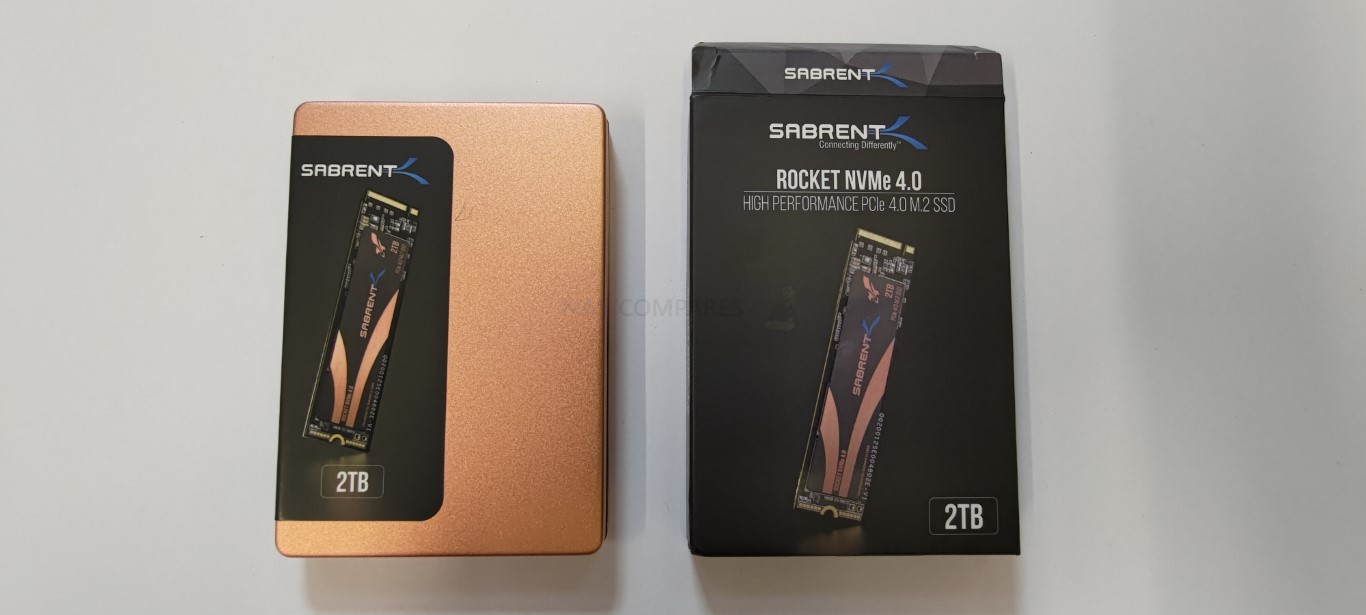
Inside the Rocket 4.0 retail box (with its promised performance abilities and specifications detailed) is a copper hinged case that is surprisingly sturdy and gives off a nice feeling of quality.
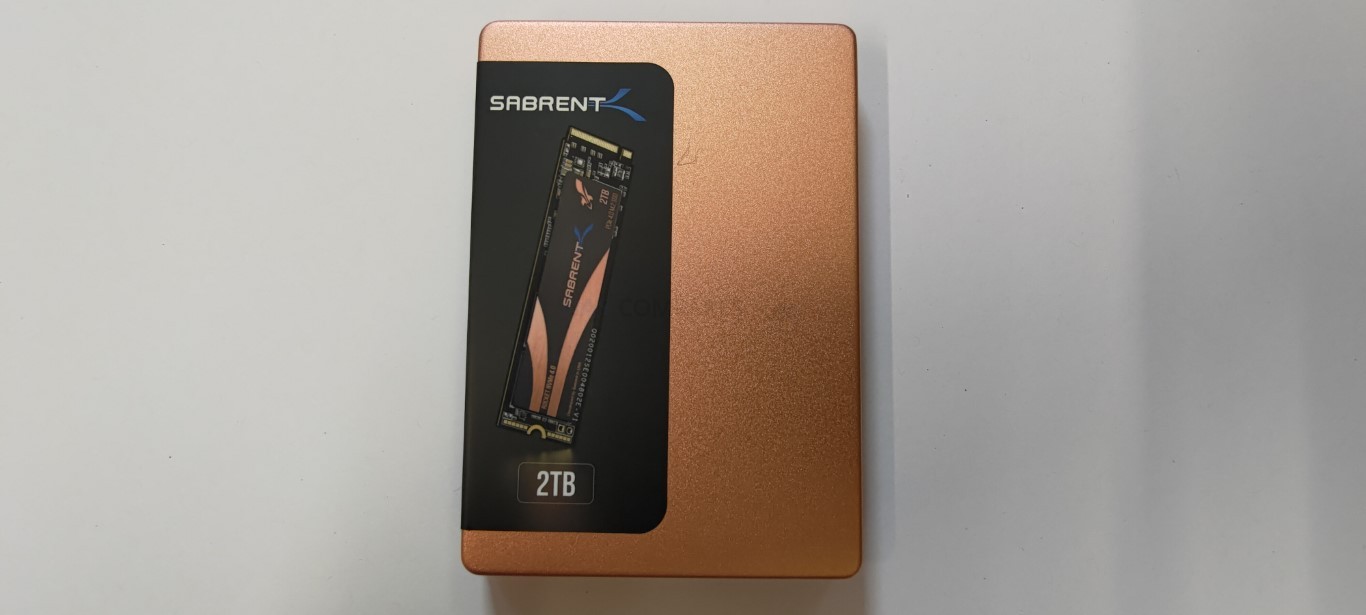
Inside this copper/rose-gold case is instructions for first-time drive installation, warranty information (which you are urged to register for, else you only have 1yr warranty as opposed to the expected 5yrs), a foam branded card that protected the M.2 NVMe and (of course) the Sabrent Rocket PCIe4 itself.
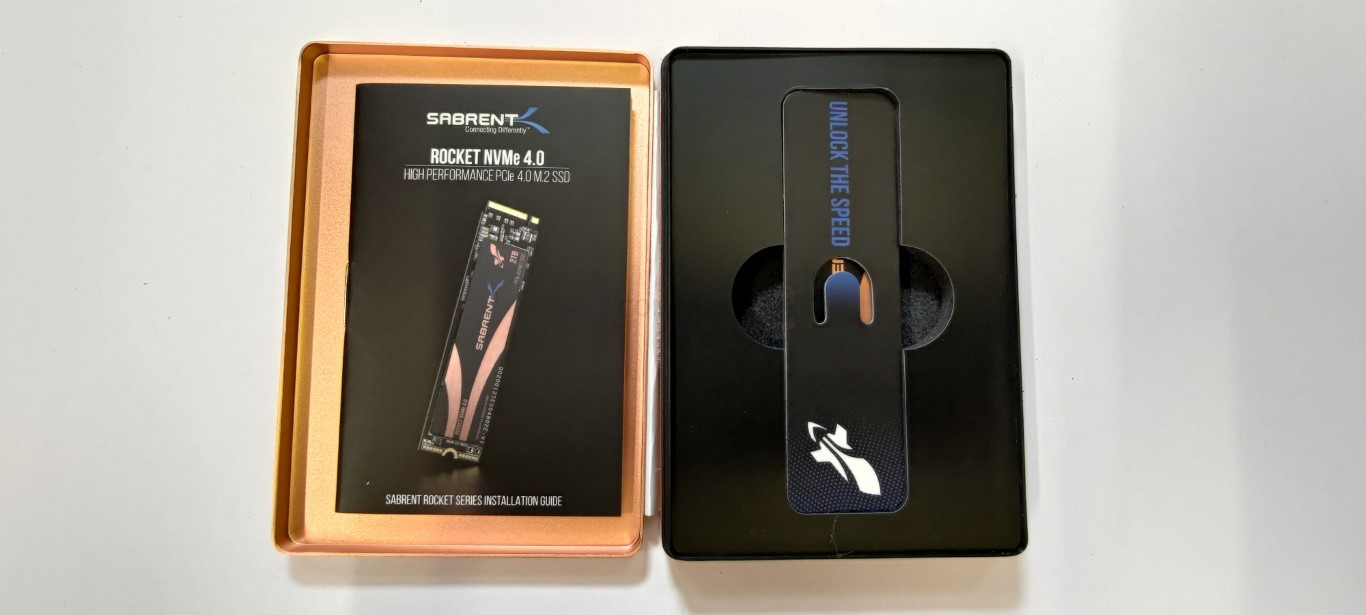
Removing the Sabrent PCIe 4.0 SSD from the carry case show you a nice and clear drive label. Indeed this label is also a little different from those that you might find on other SSDs.
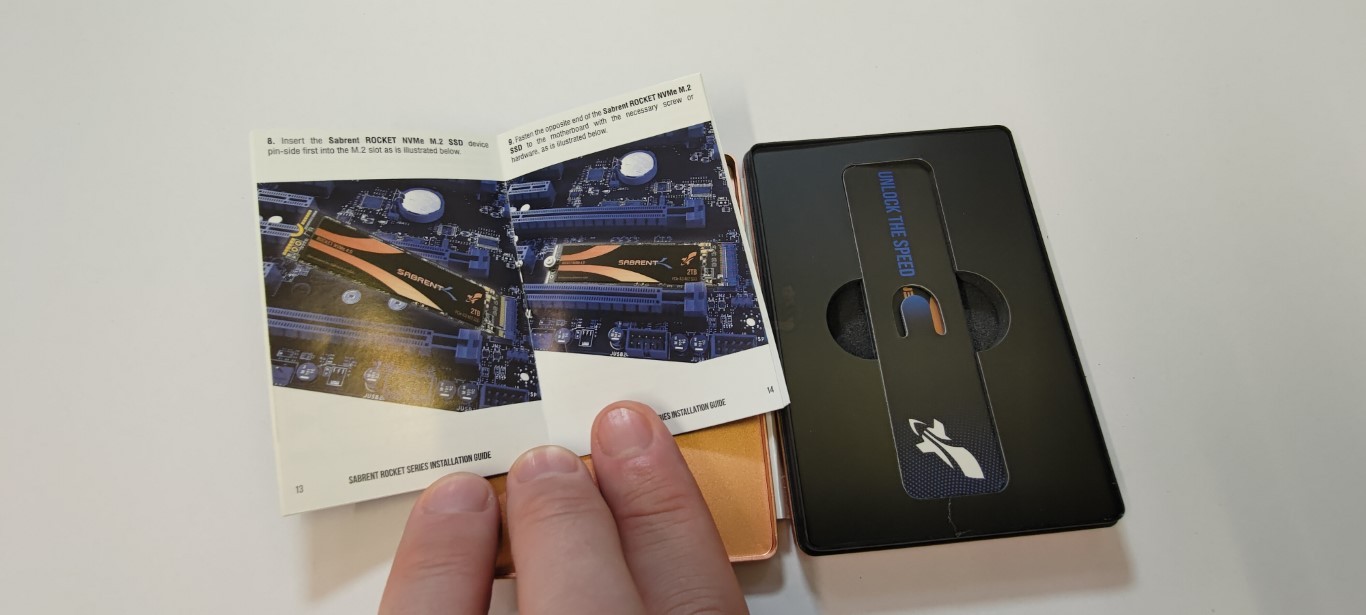
The top label of the Sabrent Rocket PCIE4.0 SSD is actually a metal place that lies across the entirety of the SSD. This plate is attached with adhesive and is present on all Sabrent NVMe SSDs, including this more consumer class PCIe4 SSD. Later we will peel back this metal plate to show you the internal NAND, Controller and Memory, but this is still a very slick touch and although I query its effectiveness in real-world usage for heat dissipation, it’s still a nice extra touch of design.
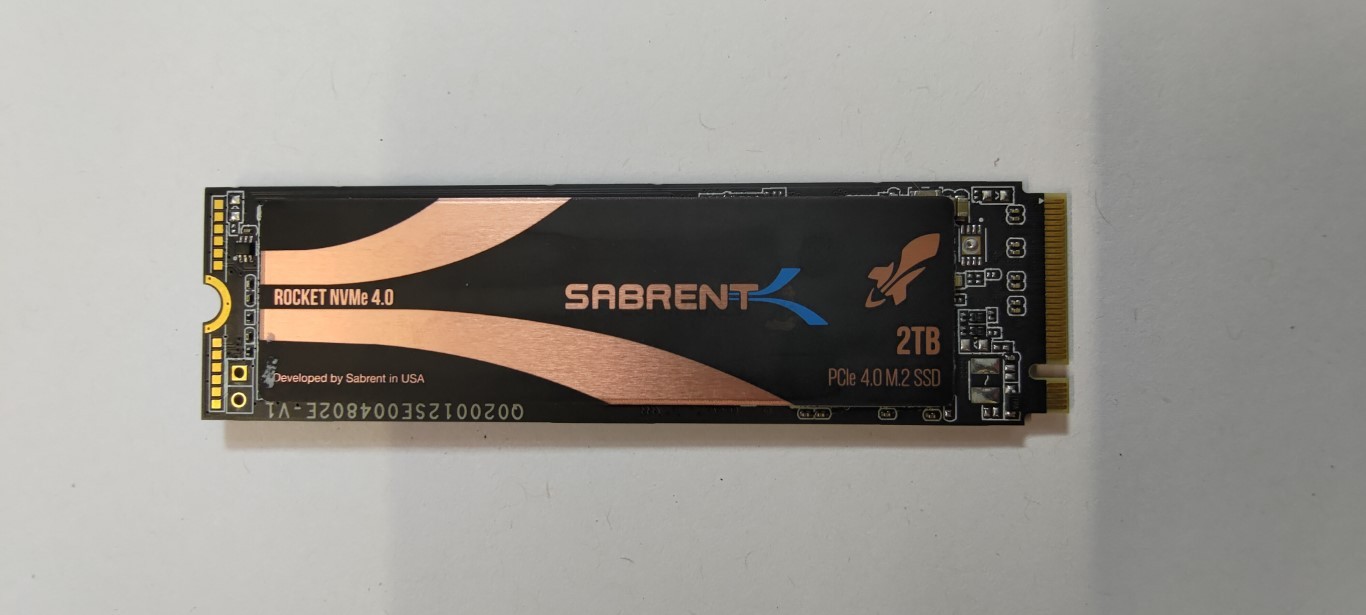
The m.2 Connector on the Sabrent Rocket 4.0 has plenty of clearance and the distribution of the NAND on this drive is very even. We are reviewing the 2TB model of this SSD series and therefore there is little need to be conservative about the spacing of NAND/Components.
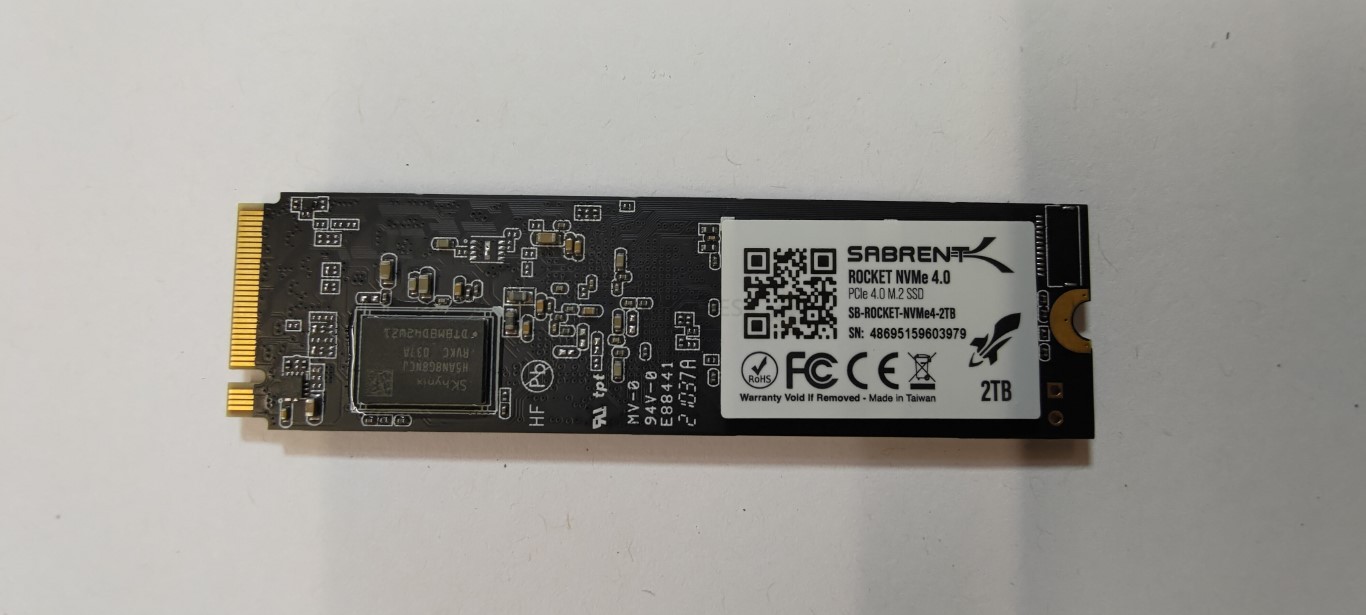
Of course, if you are going to deploy the Sabrent Rocket PCIe 4 SSD in your PC or PS5 console, it is worth remembering that these drives get hot, plus in the case of the Sabrent PCIe4, it gets remarkably hot! To counter this you can always get a 3rd party heatsink OR get the Sabrent Rocket+Heatsink package. The heatsink that Sabrent supply for this SSD is both stylized similarly to the drive itself and made of impressive build quality. However, there are a few caveats that are worth keeping in mind.
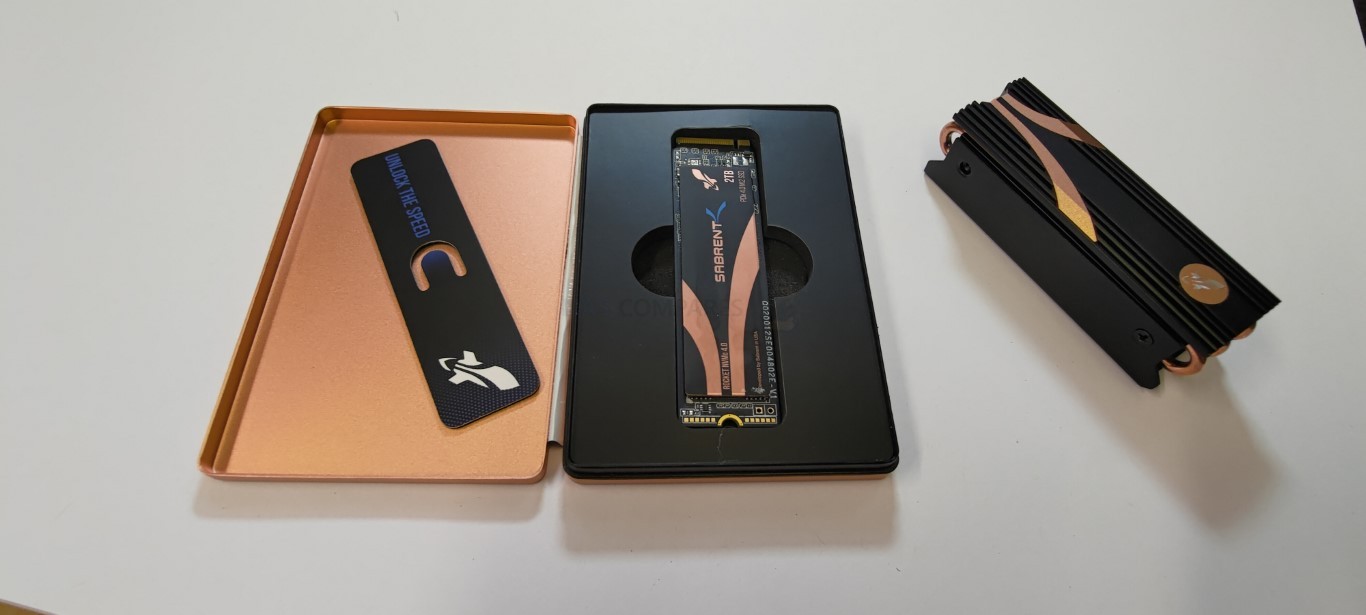
First, unlike a lot of SSDs that when purchased in complete packages with the first party/branded heatsink, the Sabrent Rocket PCIe 4.0 does NOT arrive pre-installed in the heatsink. This is NOT a big deal, as its not exactly brain surgery to install an SSD inside a heatsink, however, two of the main benefits of buying an SSD+Heatsink combo is that 1) the thermal pads can/will be applied to the precisely most beneficial elements of the SSD (eg not a long, inefficient thermal pad, but selective area application to the SSD), and 2) a SSD+Heatsink combo might be applied at factory level with dust/air control meaning better-sealed installation. These are very minor points, however, it’s a real shame that the Sabrent Rocket PCIe 4.0+Heatsink combo kit does not arrive readily attached at the point of manufacture. Another point that is worth noting, if largely not advisable, is if you are considering installing the Sabrent Rocket PCIe 4.0 drive in your PS5. It is still technically below the recommended minimum for drive installation and you might encounter gameplay issues later, but nonetheless, the drive is supported and WAS displayed as usable by the PS5 system software (currently in the beta at the time of writing and not a full-public release feature).
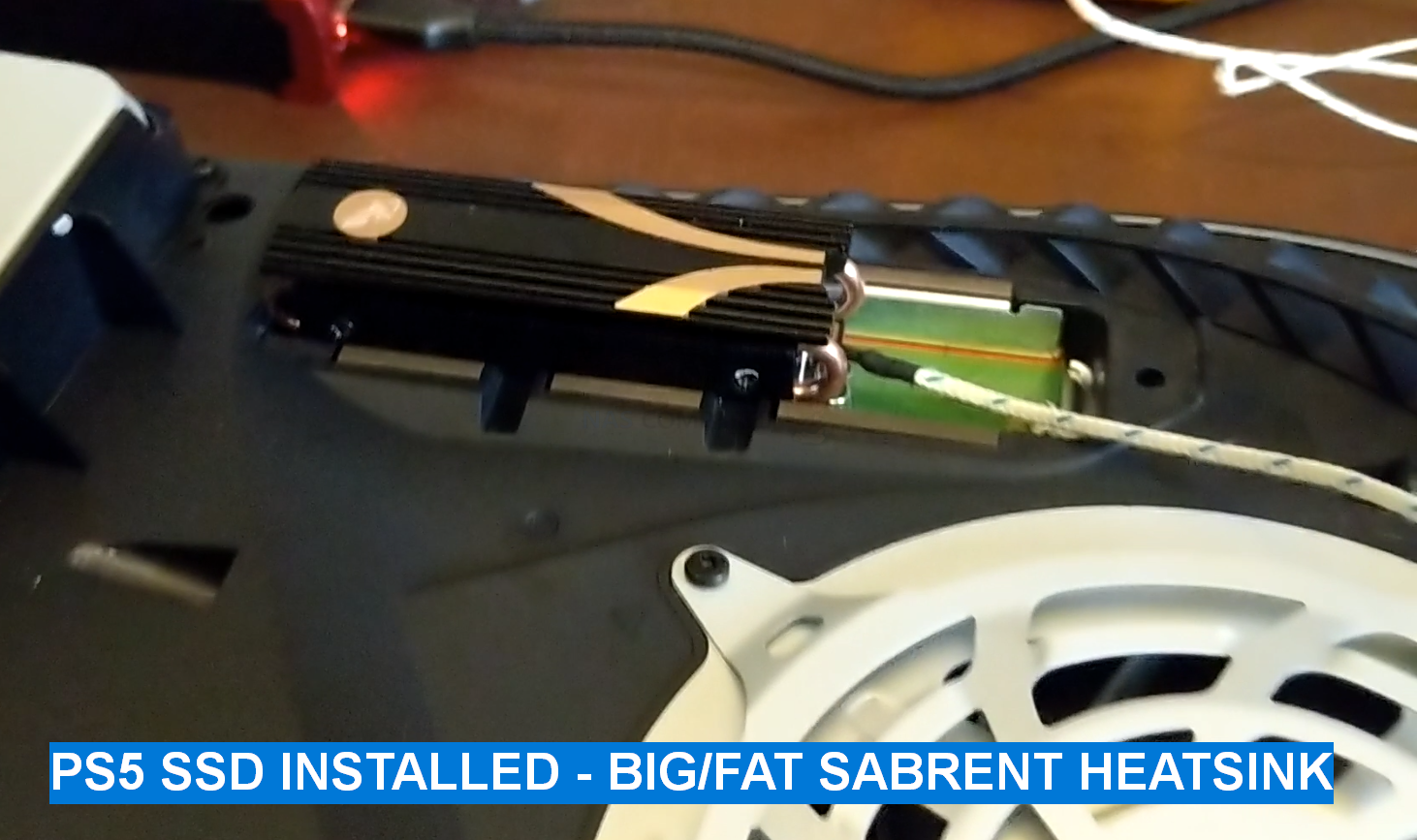
However, the 1st party Sabrent Heatsink is way, WAY too tall for PS5 expansion bay and will not allow you to install the m.2 cover by a big margin. You can still install the PS5 outer shell and panels, but this might well affect airflow too (TBC). When you uninstall the Sabrent Rocket PCIe 4 inside a PS5 with supported SSD expansion update in the expansion slot, the Playstation 5 System software recorded a highly unusual read speed of 5,622MB/s. This is significantly higher than the reported maximum 5,000MB/s Sequential Read that Sabrent themselves say the Rocket 4.0 is capable of. So, take that measurement with a MASSIVE grain of salt!
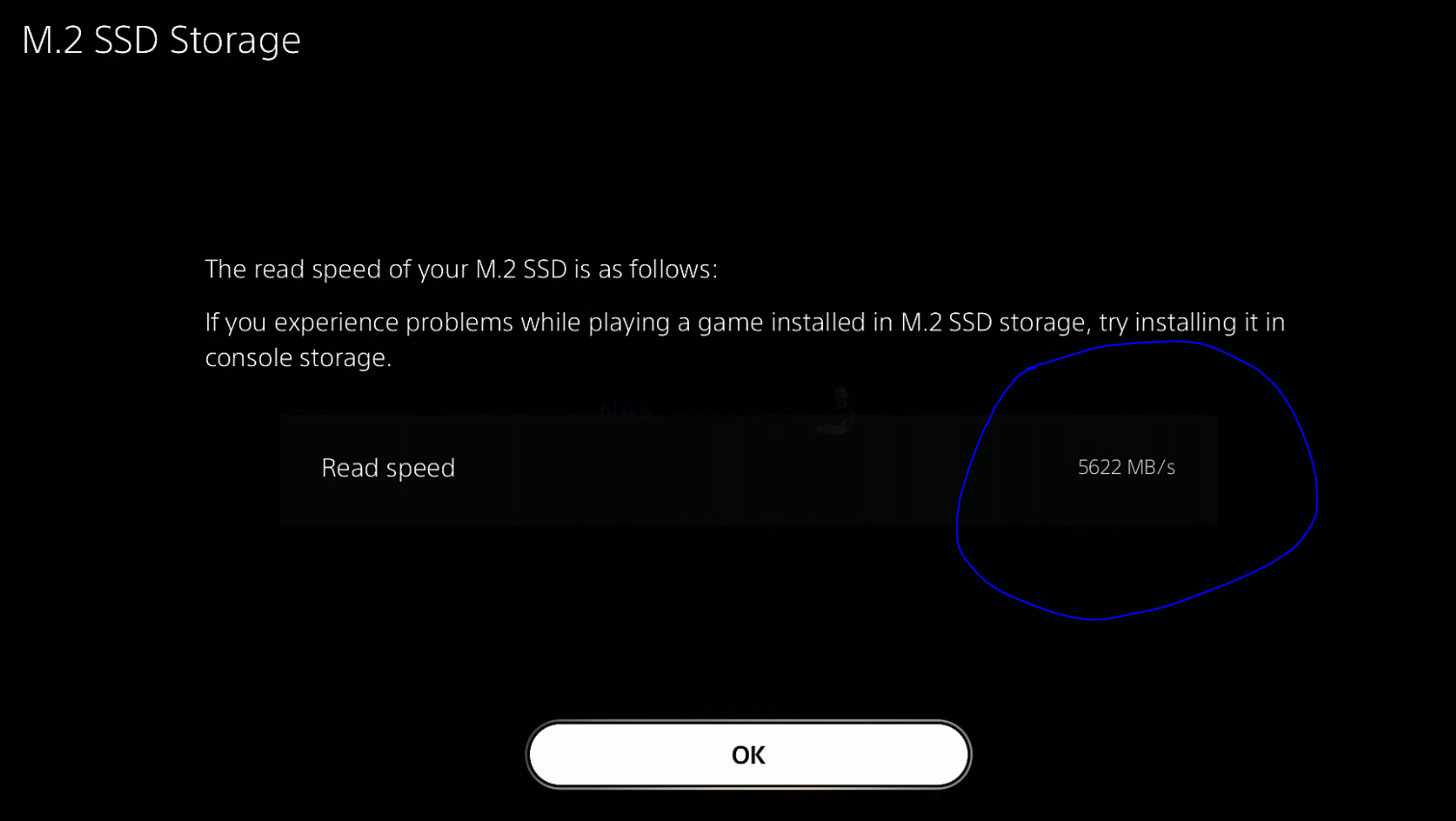
So that is the physical design of the Sabrent Rocket PCIe 4.0 SSD. But what about the hardware components themselves? Does the Sabrent Rocket PCIe 4.0 cut the mustard in terms of current generation hardware and protocols? Let’s find out.
Sabrent Rocket PCIe 4.0 SSD Review – Hardware Specifications
As you might expect from an M.2 NVMe SSD that boldly promises performance of over 5,000MB/s sequential read (ie BIG data), the hardware specifications and architecture of the Sabrent Rocket PCIe 4.0 are quite modern. Indeed, for all the big talk of the Seagate Firecuda 530 hardware (still currently the ‘score to beat’ PCIE Gen4 m.2 NVMe right now) being top tier, the Sabrent Rocket PCIe 4.0 is pretty darn similar on the spec sheet to the firecuda 520 that came before it! There is, of course, the higher tier Sabrent Rocket 4 Plus premium model, which arrives around 15-20& more expensive, but what this gives in performance, it loses in endurance and cost per TB. Below is how the Sabrent Rocket PCIe4 looks:
| Sabrent Rocket PCIe4
|
|
| PCIe Generation | PCIe Gen 4 |
| NVMe Rev | NVMe 1.3 |
| NAND | 3D TLC KIOXIA 96L |
| Max Capacity | 2TB – Single Sided |
| Controller | Phison E16-PS5016 |
| Warranty | 1yr/5yr |
I know a lot of the above will seem needlessly technical, so below we can bring the most important considerations into sharper focus.
Hardware Focus of the Sabrent Rocket PCIe 4.0 SSD Series
The first thing to focus on is the controller, that Phison E16. An SSD is much like a microcosm version of a whole computer. The Controller is equivalent to the CPU, and Phison are one of the bigger 3rd party SSD controller manufacturers in the world! I say 3rd party, because some long-running storage brands like Samsung and WD have most of their development and hardware engineering ‘in-house’ and use their own branded controllers. Whereas some brands source some/all components for their SSDs from 3rd parties – which is not necessarily a bad thing for both them and the industry (there are pros and cons on either side). Phison has been at the cutting edge of this subject for years now and the E16 was first introduced into the hardware market back in summer 2019 and is featured prominently on a number of PCIe4 SSDs that are now a pinch more affordable than the latest revision, the E18. This has created a two-tier system in the M.2 PCIe 4 market that some brands have used to produce two kinds of PCIe4 in their portfolio. A more affordable E16 SSD and a premium E18 SSD. Regardless of how the Phison E16 has slipped into the lower pricing/performance tier, this controller is still one of the biggest reasons that the Sabrent Rocket PCIe4 can actually back up its promises about the 5,000-4,400MB/s+ Sequential Read (sequential data = big chunks of data)
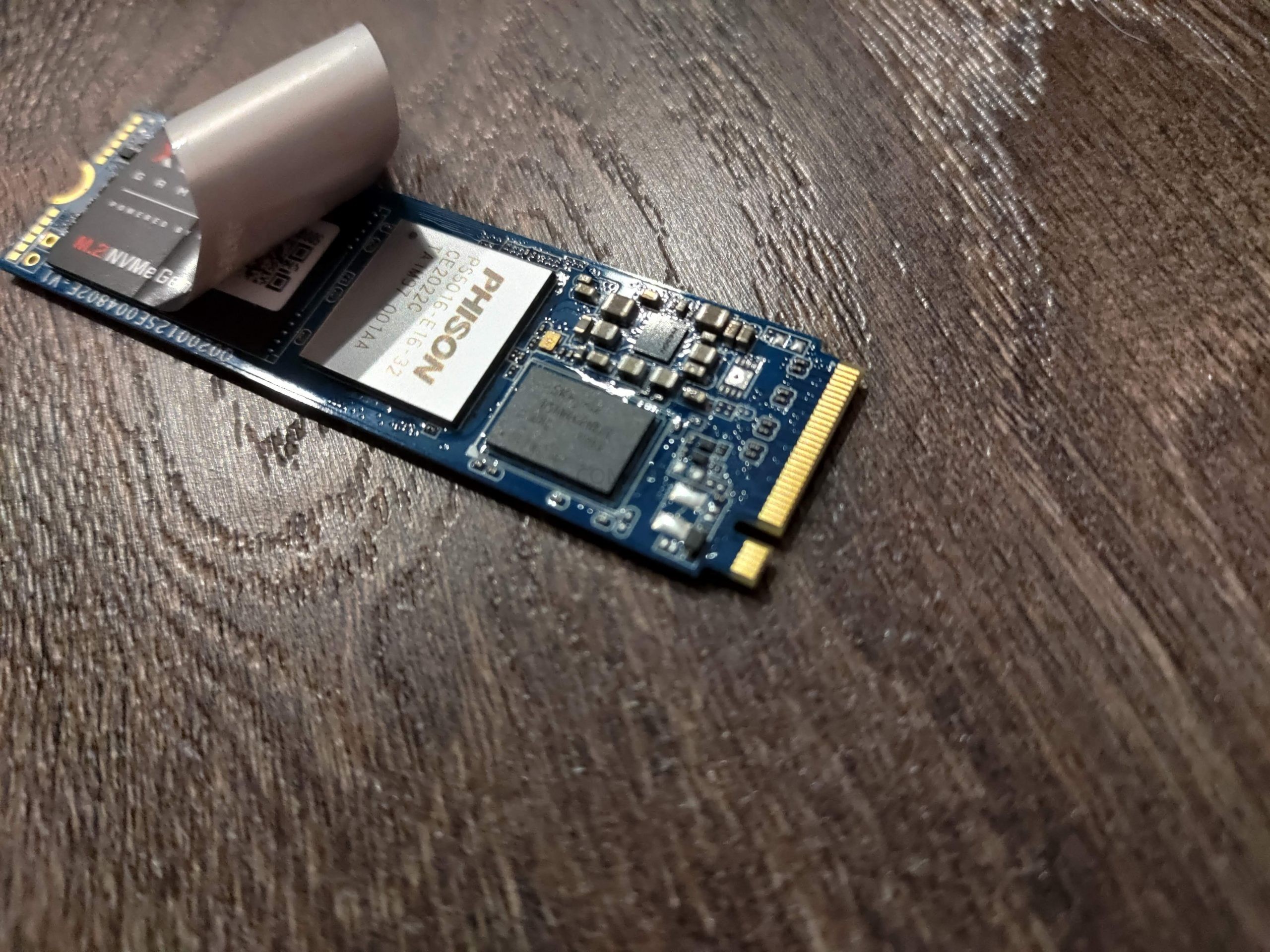
The NAND on the Sabrent Rocket PCIe 4.0 is where the data lives! SSDs (as you no doubt know) do not use moving parts as found in traditional hard drives and instead uses cells that are charged and data is read/written to them in this process. The quality of the NAND and the layers used will make a big difference to the durability and performance of an SSD and although the Sabrent Rocket PCIe 4.0 does not provide the best SSD in the industry at this tier right now (that, once again, goes to the Seagate Firecuda 530 at 176 layer 3D TLC NAND), it is bigger than most, arriving at 96 Layers of 3D TLC NAND. Although the majority of modern PCIe M.2 SSD use 3D TLC NAND (avoid QLC NAND like the PLAGUE btw!), most are still at 64 layers or so, so this is a big jump up for the Sabrent Rocket PCIe 4.0 SSD.
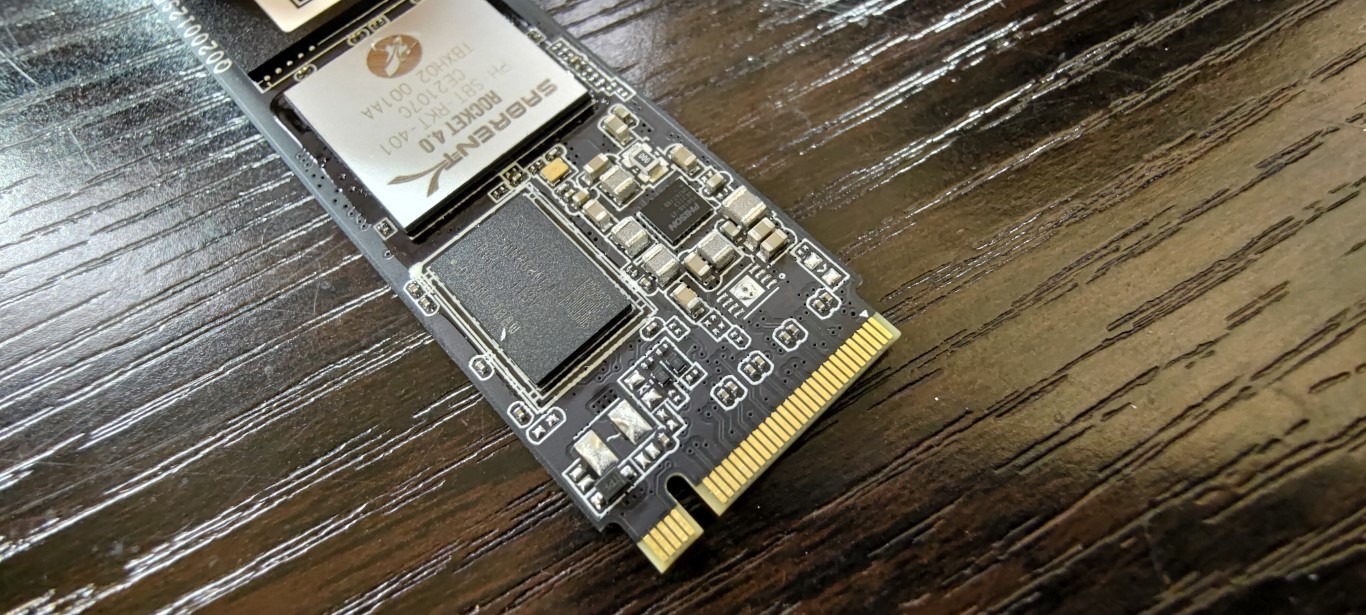
Much like the Controller on the Sabrent Rocket PCIe 4.0 being the ‘CPU’, it also has an area of memory. The Sabrent Rocket PCIe 4.0 SSD uses 1GB DDR4 memory on board and this in conjunction with the SSD provides a massive body of data handling resources for getting your data moving through the SSD and out of the m.2 NVMe PCIe 4 interface. The amount of memory scales in conjunction with the 1TB or 2TB SSD you use, with 2GB of DDR4 at the on the 2TB tier, 1GB DDR4 on the 1TB, etc.
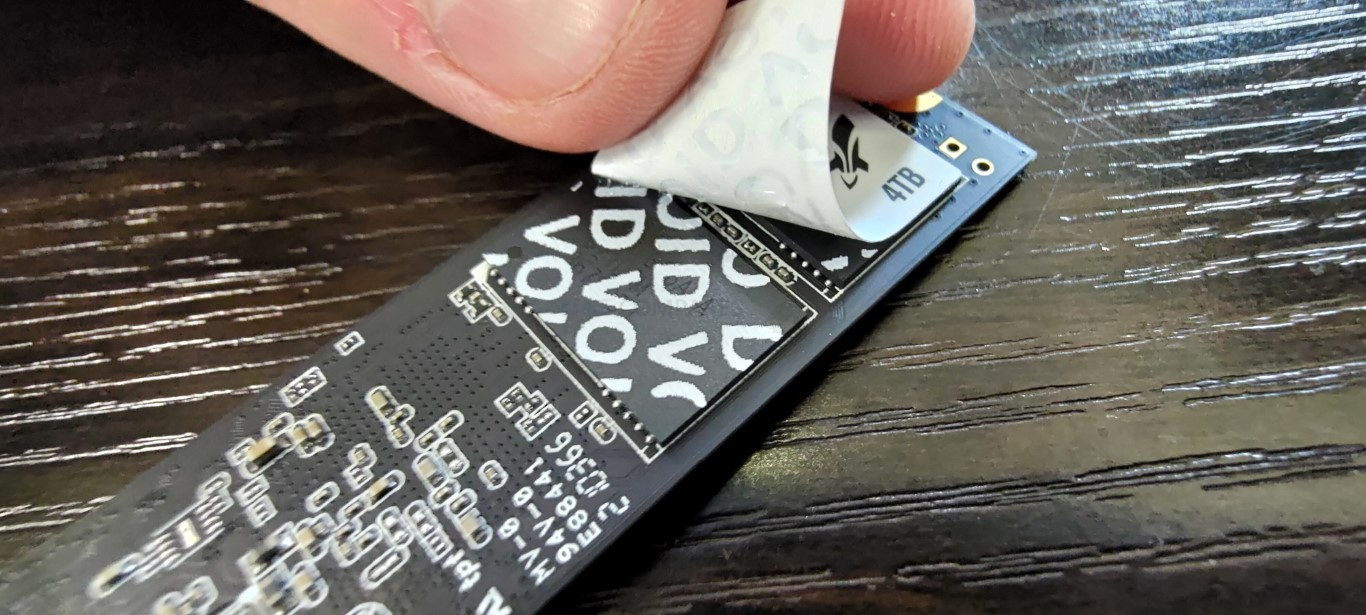
As mentioned, all available capacities of the Sabrent Rocket PCIe 4.0 arrive at 2280 in length. This is quite normal for the 1TB and 2TB versions, but the fact that the 2TB can arrive on single-sided SSD boards is very impressive. Physical storage NAND is distributed evenly in order to space out the storage and allow even cooling, NAND wear and performance.
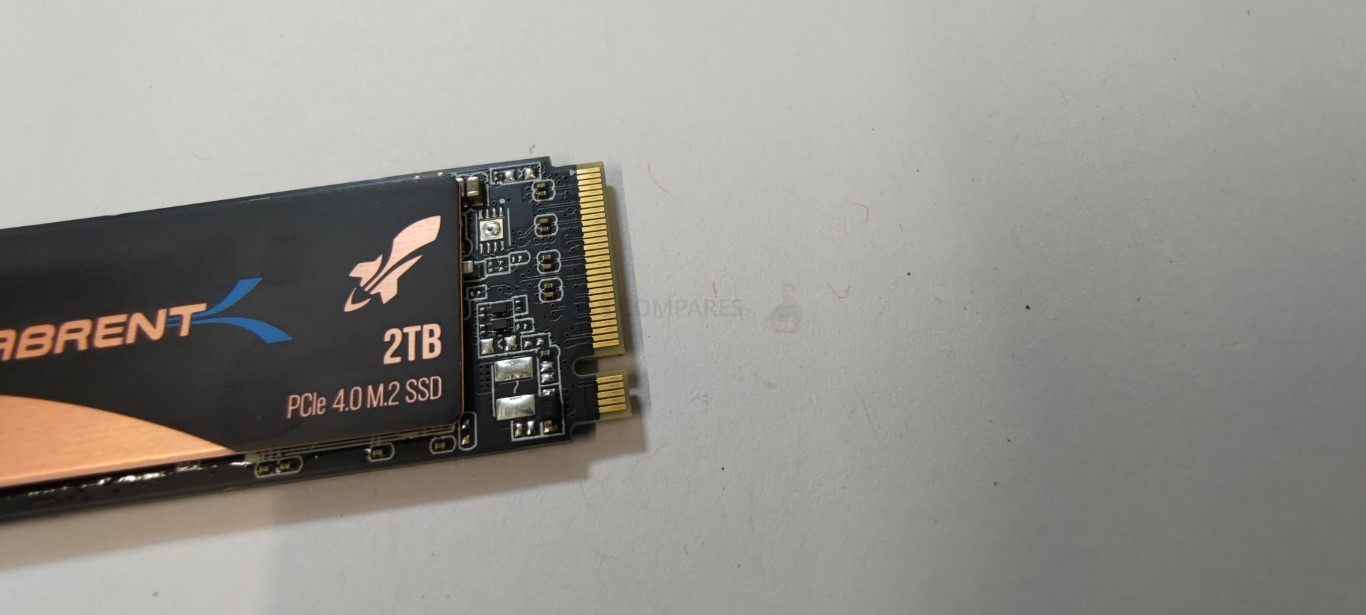
Finally, there is the M.2 NVMe connection. Not all m.2 SSDs are created equal and although M.2 SATA and M.2 NVMe look similar, they provide massively different performance and connectivity. However, the Sabrent Rocket PCIe 4.0 takes it one step further, by using a newer generation of PCIe Connectivity. In short, M.2 NVMe SSDs are connected to the host PC/Console system via PCIe protocol (think of those slots that you almost always use for your graphics cards, but a much, MUCH smaller connector). These allow much larger bandwidth (ie maximum speed) for the connected storage media, Much like regular PCIe slots, they have different versions (i.E PCIe Gen 1, 2, 3, 4, etc) and also a multiplying factor (x1, x2, x4, etc). Up until around 18 months ago, the best M.2 NVMes were M.2 PCIe Gen 3×4 (so a maximum 4,000MB/s possible). However, never generation SSD like the Sabrent Rocket PCIe 4.0 use PCIe Gen 4×4 (a potential 8,000MB/s possible) and it is only now that SSD controllers and NAND production has reached a point where it can catch up and fully saturate (i.e fill) this connection.
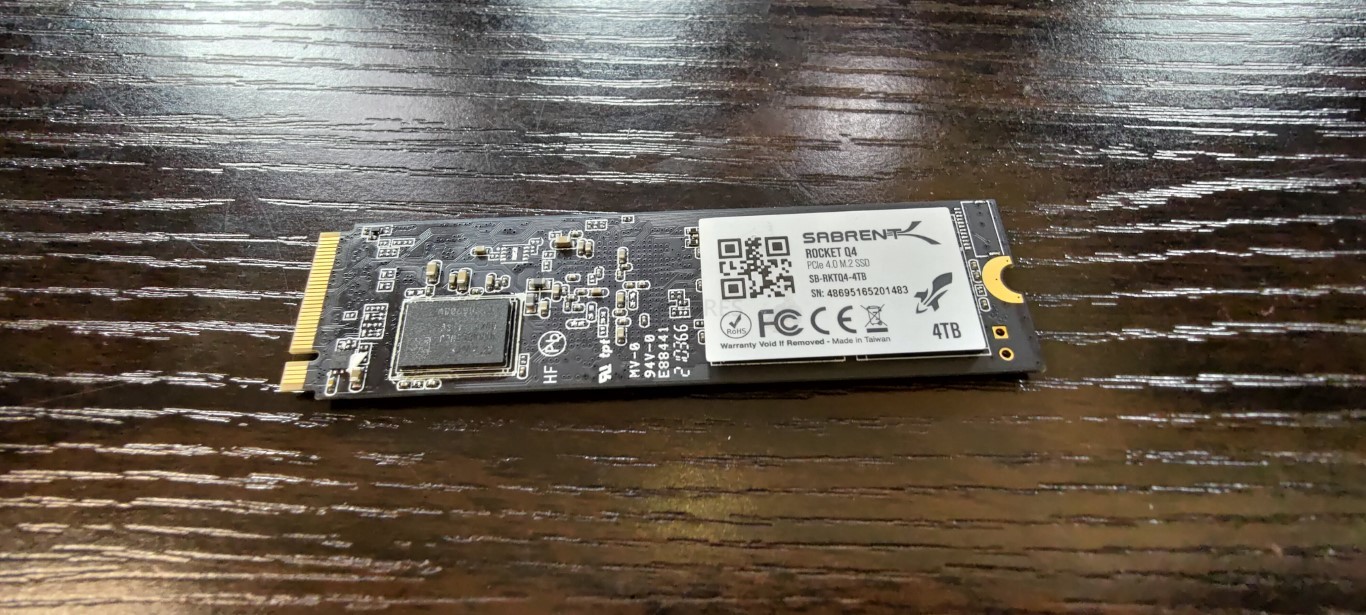
Overall, you really cannot fault the hardware inside/onboard the Sabrent Rocket PCIe 4.0, as it is still (2-3 months after release) higher performing in sequential Read and Write than many other M.2 NVMe PCIe 4 SSDs released in that time. Before we go into the full testing, however, it is worth taking a moment to look closely at the reported performance benchmarks of the Sabrent Rocket PCIe 4.0, as although the performance seems stellar, there are areas such as IOPS and endurance when compared with its main rivals that are worth taking into consideration.
Sabrent Rocket PCIe 4.0 SSD Review – Official Stats First
Before we conduct our own testing on this SSD, Let’s take a closer look at the reported specifications and benchmarks first. The Sabrent Rocket PCIe 4.0 SSD arrives in multiple capacities (below). The Prices currently are a little inconsistent (with each higher capacity tier actually having a higher price per GB – quite unusual) likely due to the hardware shortages, the Pandemic, Chia has affected SSD availability in the last 12 months and most recently the announcement that PS5 supports this SSD and it has increased the current price of both models around 10%! Below is a breakdown of how each Sabrent Rocket PCIe 4.0 SSD compares:
| Brand/Series | Sabrent Rocket PCIe4
|
Seagate Firecuda 530
500GB – $149.99, 1TB – $239.99, 2TB – $489.99, 4TB – $949.99 |
WD Black SN850
|
| PCIe Generation | PCIe Gen 4 | PCIe Gen 4 | PCIe Gen 4 |
| NVMe Rev | NVMe 1.3 | NVMe 1.4 | NVMe 1.4 |
| NAND | 3D TLC KIOXIA 96L | 3D TLC Micron B47R 176L | BiCS4 96L TLC |
| Max Capacity | 2TB – Single Sided | 4TB – Double Sided | 2TB |
| Controller | Phison E16-PS5016 | Phison E18-PS5018 | WD_BLACK G2 |
| Warranty | 1yr/5yr | 5yr | 5yr |
| 500GB Model | SB-RKTQ4-500GB | ZP500GM3A013 | WDS500G1X0E-00AFY0 |
| Total Terabytes Written (TBW) | 850TB | 640TB | 300TB |
| Mean Time Between Failures (MTBF, hours) | 1,700,000 | 1,800,000 | 1,750,000 |
| DWPD | 0.9DWPD | 0.7DWPD | 0.3DWPD |
| 1TB Model | SB-RKTQ4-1TB | ZP1000GM3A013 | WDS100T1X0E-00AFY0 |
| Total Terabytes Written (TBW) | 1800TB | 1275TB | 600TB |
| Mean Time Between Failures (MTBF, hours) | 1,700,000 | 1,800,000 | 1,750,000 |
| DWPD | 0.9DWPD | 0.7DWPD | 0.3DWPD |
| 2TB Model | SB-RKTQ4-2TB | ZP2000GM3A013 | WDS200T1X0E-00AFY0 |
| Total Terabytes Written (TBW) | 3600TB | 2550TB | 1200TB |
| Mean Time Between Failures (MTBF, hours) | 1,700,000 | 1,800,000 | 1,750,000 |
| DWPD | 0.9DWPD | 0.7DWPD | 0.3DWPD |
| 4TB Model | N/A | ZP4000GM3A013 | N/A |
| Total Terabytes Written (TBW) | N/A | 5100TB | N/A |
| Mean Time Between Failures (MTBF, hours) | N/A | 1,800,000 | N/A |
| DWPD | N/A | 0.7DWPD | N/A |
There are clear throughput improvements as you rise through the capacity tiers (not unusual), as does the rated 4K IOPS. Though one area worth focusing on a little is that TBW (terabytes Written) and DWPD (Drive writes per day), as this drive is THREE TIMES HIGHER than the Samsung 980 Pro and WD Black SN850 in terms of NAND lifespan on daily writes, likely down to that Kioxia 96 Layer 3D TLC NAND used, rather than the used by those used by competitors. This is an important point because the brand has significantly less pedigree in-home/business SSD media than the likes of Samsung, WD and Seagate and people will want to know they are going to get a product that lasts!
However, despite the use of the Phison E16 controller and 96 layer NAND, the reported IOPS on each capacity is actually a noticeable degree lower than those reported by their competitors. Indeed, the Sabrent Rocket PCIe 4.0 is one of the few E18 SSDs that does not cross into the reported 1 Million IOPS mark, maxing out at 700k. This is still very impressive anyway, but it does make me wonder where the disparity stems from. Indeed, when you look at the bulk of PCIe 4×4 M.2 NVMe 1.4 SSD, that feature the E18 controller and 96L (or higher) on board, it really only leaves about 4 other SSDs in the market today that this can be compared against. The Sabrent Rocket 4 Plus, the MSI Spatium M480, the ADATA Gammix S70 and (current leader) the Seagate Firecuda 530. Of those, the only one that seemingly ‘out specs’ the Sabrent Rocket PCIe 4.0 is the Seagate Firecuda 530. However, the Sabrent Rocket PCIe 4.0 SSD has been available in the market for almost 14 months longer and has certainly embedded itself in the market at that time more. Below is how these two drives compare:
| Brand/Series | Sabrent Rocket PCIe4
|
Seagate Firecuda 530
500GB – $149.99, 1TB – $239.99, 2TB – $489.99, 4TB – $949.99 |
WD Black SN850
|
| 500GB Model | SB-RKTQ4-500GB | ZP500GM3A013 | WDS500G1X0E-00AFY0 |
| Sequential Read (Max, MB/s), 128 KB | 5000MB | 7000MB | 7000MB |
| Sequential Write (Max, MB/s), 128 KB | 2500MB | 3000MB | 4100MB |
| 1TB Model | SB-RKTQ4-1TB | ZP1000GM3A013 | WDS100T1X0E-00AFY0 |
| Sequential Read (Max, MB/s), 128 KB | 5000MB | 7300MB | 7000MB |
| Sequential Write (Max, MB/s), 128 KB | 4400MB | 6000MB | 5300MB |
| 2TB Model | SB-RKTQ4-2TB | ZP2000GM3A013 | WDS200T1X0E-00AFY0 |
| Sequential Read (Max, MB/s), 128 KB | 5000MB | 7300MB | 7000MB |
| Sequential Write (Max, MB/s), 128 KB | 4400MB | 6900MB | 5100MB |
| 4TB Model | N/A | ZP4000GM3A013 | |
| Sequential Read (Max, MB/s), 128 KB | N/A | 7300MB | N/A |
| Sequential Write (Max, MB/s), 128 KB | N/A | 6900MB | N/A |
| Brand/Series | Sabrent Rocket PCIe4 | Seagate Firecuda 530 | WD Black SN850 |
| 500GB Model | SB-RKTQ4-500GB | ZP500GM3A013 | WDS500G1X0E-00AFY0 |
| Random Read (Max, IOPS), 4 KB QD32 | 400000 | 400,000 | 1,000,000 |
| Random Write (Max, IOPS), 4 KB QD32 | 550000 | 700,000 | 680,000 |
| 1TB Model | SB-RKTQ4-1TB | ZP1000GM3A013 | WDS100T1X0E-00AFY0 |
| Random Read (Max, IOPS), 4 KB QD32 | 750,000 | 800000 | 1,000,000 |
| Random Write (Max, IOPS), 4 KB QD32 | 750,000 | 1000000 | 720,000 |
| 2TB Model | SB-RKTQ4-2TB | ZP2000GM3A013 | WDS200T1X0E-00AFY0 |
| Random Read (Max, IOPS), 4 KB QD32 | 750,000 | 1,000,000 | 1,000,000 |
| Random Write (Max, IOPS), 4 KB QD32 | 850TB | 1,000,000 | 710,000 |
| 4TB Model | N/A | ZP4000GM3A013 | |
| Random Read (Max, IOPS), 4 KB QD32 | N/A | 1,000,000 | N/A |
| Random Write (Max, IOPS), 4 KB QD32 | N/A | 1,000,000 | N/A |
Yes, that is a LONG table, but you can immediately see that the Seagate Firecuda 530 raises the stakes on all of the key specifications. Although there are a number of micro reasons for this, the 176L NAND is the biggest factor here. Yes, that is why the Firecuda 530 commands the higher price tag. Additionally, the WD Black arriving at a better price point, higher IOPS in most tiers and the fact it does this whilst still hitting that 7,000MB/s certainly gives pause for thought. However, for many, the additional cost for higher durability they may never need, peak performance their core system will not reach and IOPS rating that their larger file handling will never utilize will mean that holding out for the Firecuda or WD Black SN850 is not in their interest. Both SSDs (on paper at this stage!) are fantastic examples of where consumer and prosumer SSDs are evolving towards. Let’s get the Sabrent Rocket PCIe 4.0 on the test machine!
Testing the Sabrent Rocket PCIe 4.0 m.2 PCIE4 NVMe SSD
The Sabrent Rocket PCIe 4.0 was selected for this test and it was tested using multiple benchmark tools, from a cold boot, in the 2nd storage slot (i.e not the OS drive). Each test was conducted three times (full details of this are shown in the YouTube Review of the Sabrent Rocket PCIe 4.0 over on NASCompares):
Test Machine:
- Windows 10 Pro Desktop System
- Intel i5 11400 Rocket Lake – 6-Core 2.6/4.4Ghz
- 16GB DDR4 2666MHz Memory
- Intel B560M mATX Motherboard
- OS Storage, Seagate Firecuda 120 SSD
- Test SSD connected to Secondary PCIe Gen 4 M.2 Slot
Using CrystalDisk, we got a good measure of the drive and verified that this PCIe Gen 4 x4 SSD was indeed using the 4×4 lane. Additionally, the temp averaged out around 44C between each test being conducted.
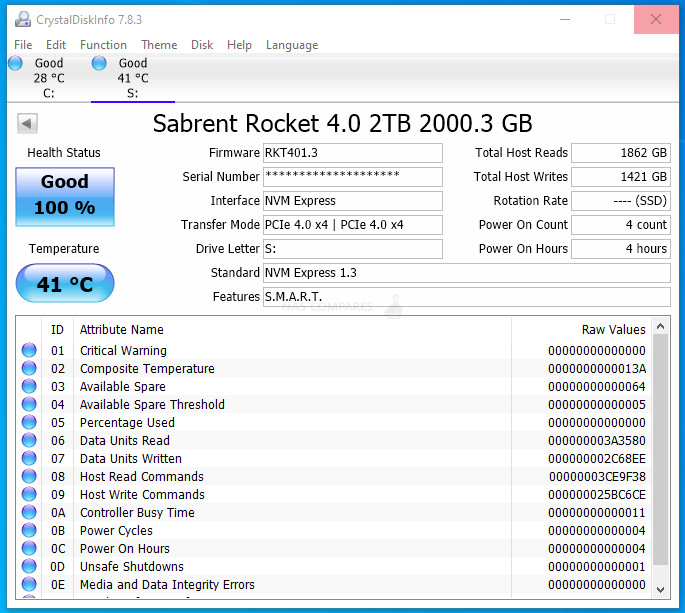
The first tests were conducted using the ATTO disk benchmark software. The first was a 256MB test file size and below is a breakdown of the transfer rates and IOPS. The 2nd Test was a 1GB test file and finally, the last test was with a 4GB test file. The system was given 1-minute cool downtime between tests, no screen recording software was used (remove overhead) and a heatsink was used throughout (no reboots)
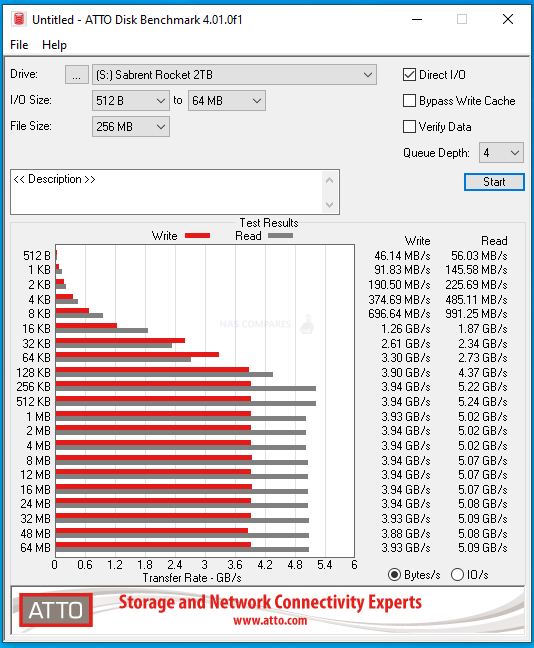 |
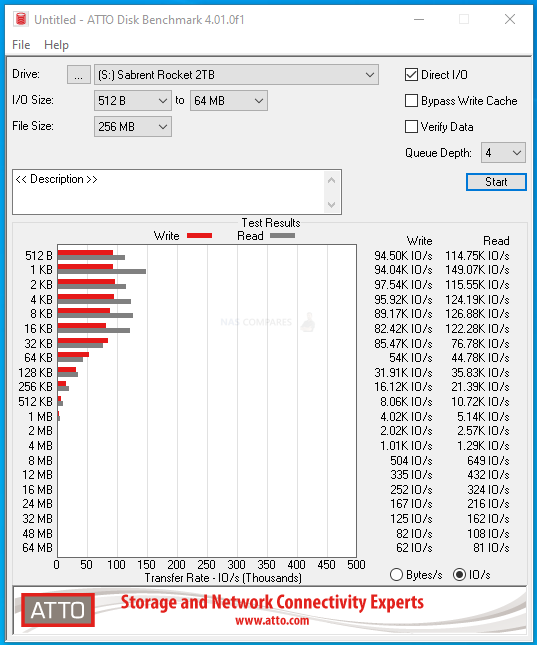 |
ATTO Disk Benchmark Test #1
256MB File PEAK Read Throughput = 5.24GB/s
256MB File PEAK Write Throughput = 3.94GB/s
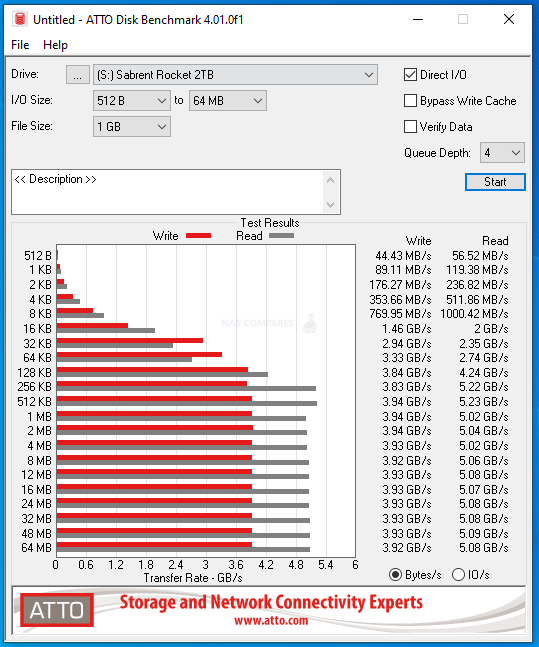 |
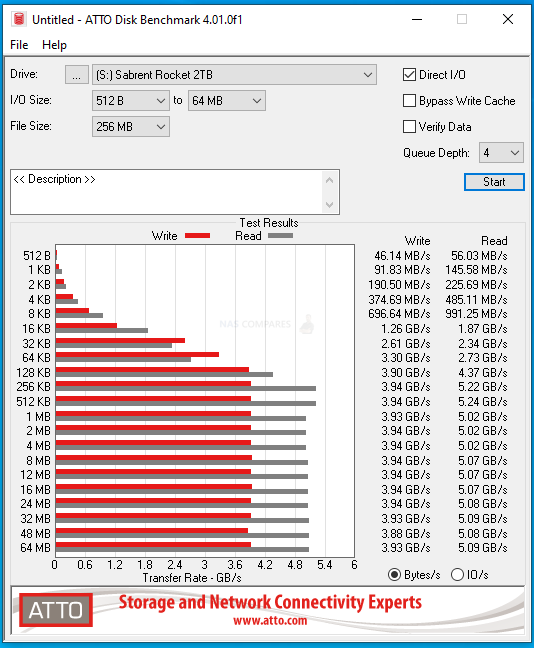 |
ATTO Disk Benchmark Test #2
1GB File PEAK Read Throughput = 5.23GB/s
1GB File PEAK Write Throughput = 3.94GB/s
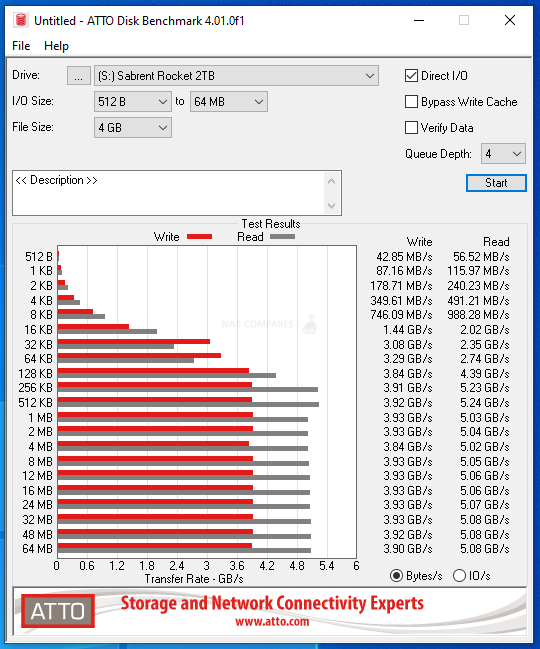 |
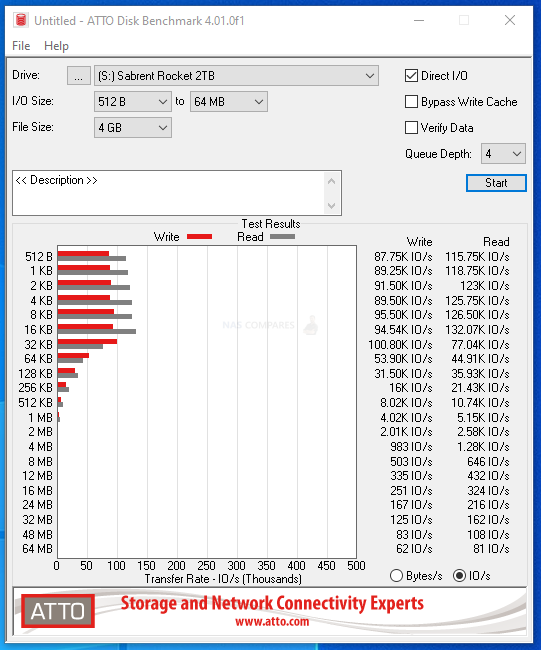 |
ATTO Disk Benchmark Test #3
4GB File PEAK Read Throughput = 5.23GB/s
4GB File PEAK Write Throughput = 3.93GB/s
Next, although the ATTO tests were quite good, but not what I would have hoped from this SSD, so I moved on to the Crystal Disk Mark testing to see how well it would handle our lasts barrage of tests. The first test was the 1GB file testing, which measured both sequential and random, as well as the read and write IOPS. Test were conducted on a 1GB, 4GB and 16GB Test File. I also included a mixed 70/30 read and write task to give a little bit more of a realistic balanced workload. These tests were conducted with 1-minute cooling break in between
CRYSTALDISK MARK 1GB TEST
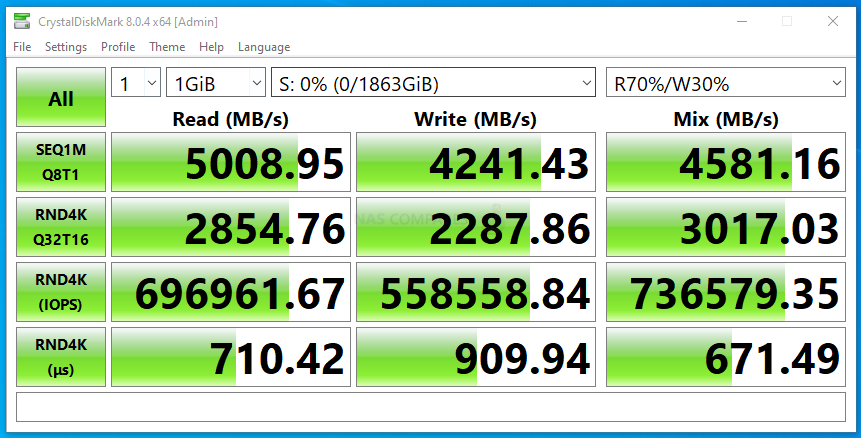
CRYSTALDISK MARK 4GB TEST
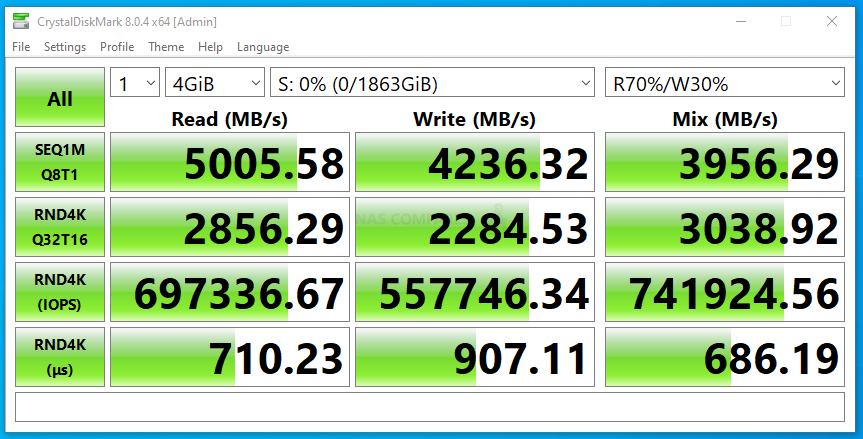
CRYSTALDISK MARK 16GB TEST
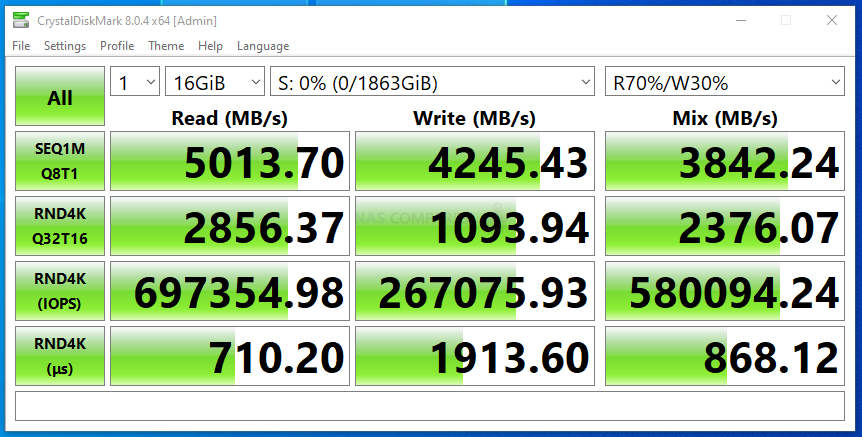
Next, I switched to AS SSD benchmark. A much more thorough test through, I used 1GB, 3GB and 5GB test files. Each test includes throughput benchmarks and IOPS that are respective to the larger file sizes (important, if you are reading this and trying to compare against the reported 4K IOPS from the manufacturer).
AS SSD Benchmark Test #1
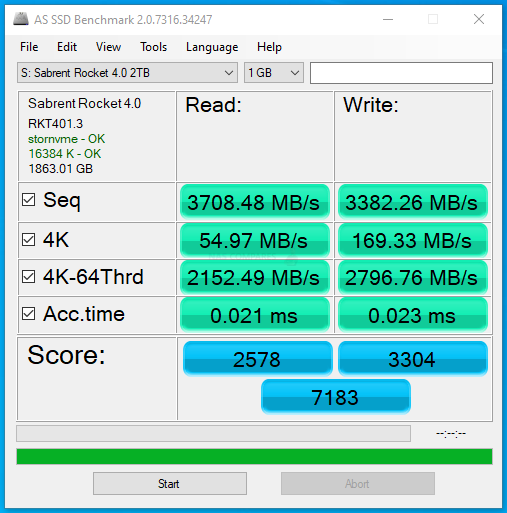 |
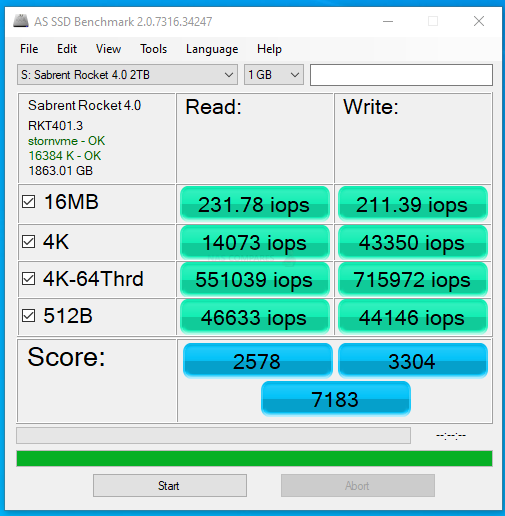 |
AS SSD Benchmark Test #2
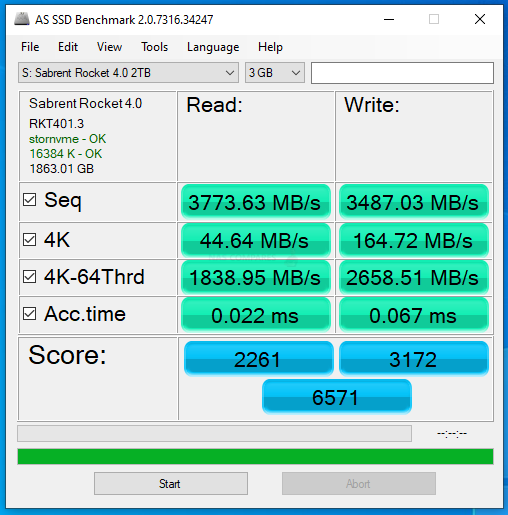 |
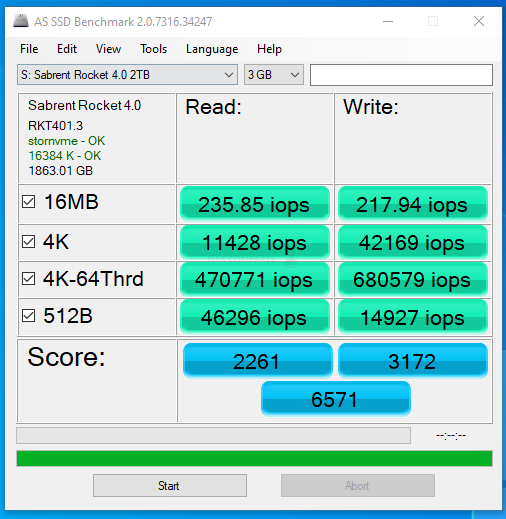 |
AS SSD Benchmark Test #3
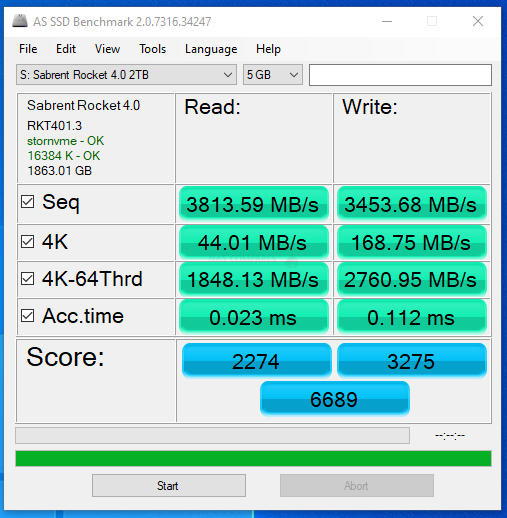 |
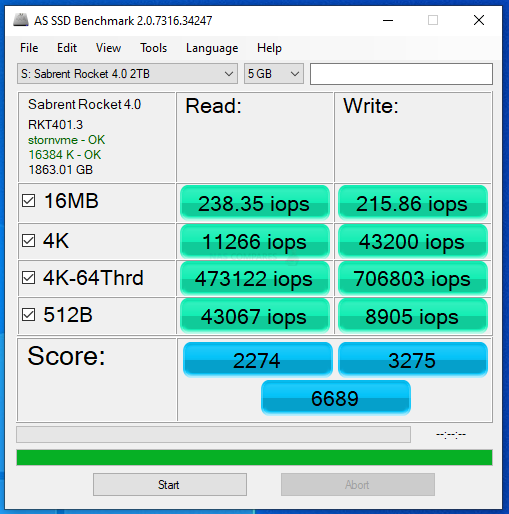 |
Ordinarily, I would introduce tests like BlackMagic and AJA into the mix here, but even a short burst of testing on an NVMe like this would over saturate the cache memory on board. Nevertheless, in the short term we still could ascertain the reported performance on 1GB, 4GB and 16GB file testing was:
1GB AJA File Test Results (Peak) = 4468MB/s Read & 4145MB/s Write

4GB AJA File Test Results (Peak) = 4487MB/s Read & 4132MB/s Write

16GB AJA File Test Results (Peak) = 4487MB/s Read & 4125MB/s Write

Overall, the Sabrent Rocket PCIe 4.0 was certainly able to provide some solid performance, as well as potentially exceed the test figures here on a more powerful machine. Given the reported Read and Write statistics that the brand has stated publically, I think there is enough evidence here to back up those claims. IOPs were a little lower than I expected, but again, we were testing very large file types, so this would have to be taken in context.
Sabrent Rocket PCIe 4.0 SSD Review – Conclusion
The Sabrent Rocket 4.0 M.2 SSD is a good, solid release that although may appear a little safe in summer 2021 compared to its release in mid-2020, is still a drive that still delivers on what it promises. In many ways, the Sabrent Rocket PCIe 4.0 is a victim of the brands own rising success (a bit overly flattering, but hear me out). Whether through accident or design, the fast-paced establishing of their range of PCIe 4.0 SSDs that cover budget buyers to Professional buyers has led to the Sabrent Rocket PCIe 4.0 SSD being somewhat overshadowed by the Rocket 4 Plus SSD. Had the numerous market-changing events of the last 18 months not happened, then the pricing structure between these three SSD tiers would be must more distinguishable. As it stands, now the Sabrent Rocket PCIe 4.0 is very close to the Rocket 4 Plus and unless a buyer is highly concerned with durability (0.9 DWPD vs 0.3 DWPD), it makes spending a tiny bit more and opting for the premium class drive a no brainer. That said, judging the Sabrent Rocket PCIe 4.0 SSD on its own merits, it is another solid release from the brand. It still features the strange warranty registration policy of the rest of the brand’s releases (nope, still can’t get behind that idea!), but the rest of the drive is exactly what I want in a all-purpose m.2 NVMe SSD. If you see this drive on sale, then do not hesitate to snap it up.
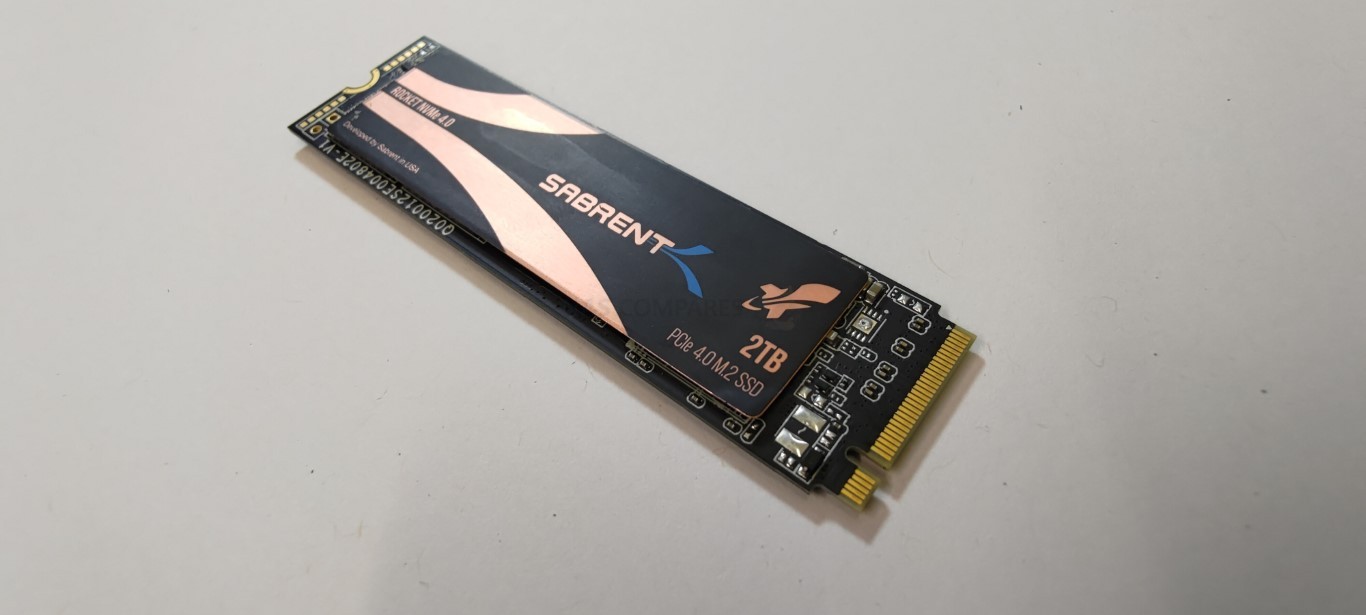
| PROs of the Sabrent Rocket PCIe 4.0 | CONs of the Sabrent Rocket PCIe 4.0 |
| Still Impressive Performance even a year since it’s release
High Durability of over 0.9 DWPD Good Drive for those with Systems that cannot reach 7000MB/s Cap tier Good Build Quality and Presentation Includes Acronis True Image to clone/move OS to drive PS5 SSD Expansion Drive Support (Negotiable – check later software releases) |
Overshadowed by the Rocket 4 Plus SSD
No 4TB Option (unless the Q4 / Rocket 4 Plus Series) SSD Pricing Madness in 2020/2021 hurts its appeal |
🔒 Join Inner Circle
Get an alert every time something gets added to this specific article!
This description contains links to Amazon. These links will take you to some of the products mentioned in today's content. As an Amazon Associate, I earn from qualifying purchases. Visit the NASCompares Deal Finder to find the best place to buy this device in your region, based on Service, Support and Reputation - Just Search for your NAS Drive in the Box Below
Need Advice on Data Storage from an Expert?
Finally, for free advice about your setup, just leave a message in the comments below here at NASCompares.com and we will get back to you. Need Help?
Where possible (and where appropriate) please provide as much information about your requirements, as then I can arrange the best answer and solution to your needs. Do not worry about your e-mail address being required, it will NOT be used in a mailing list and will NOT be used in any way other than to respond to your enquiry.
Need Help?
Where possible (and where appropriate) please provide as much information about your requirements, as then I can arrange the best answer and solution to your needs. Do not worry about your e-mail address being required, it will NOT be used in a mailing list and will NOT be used in any way other than to respond to your enquiry.

|
 |
Beelink ME Pro NAS Revealed
Best SOLID STORAGE NAS of 2025
Should You Worry About the NanoKVM Hidden Microphone?
Best Cheap NAS of 2025
Minisforum MS-02 Ultra - WHO IS THIS FOR??? (The First 48HRs)
Why People Use TrueNAS, UnRAID and Proxmox to Turnkey NAS (Synology, QNAP, etc)
Access content via Patreon or KO-FI





Discover more from NAS Compares
Subscribe to get the latest posts sent to your email.


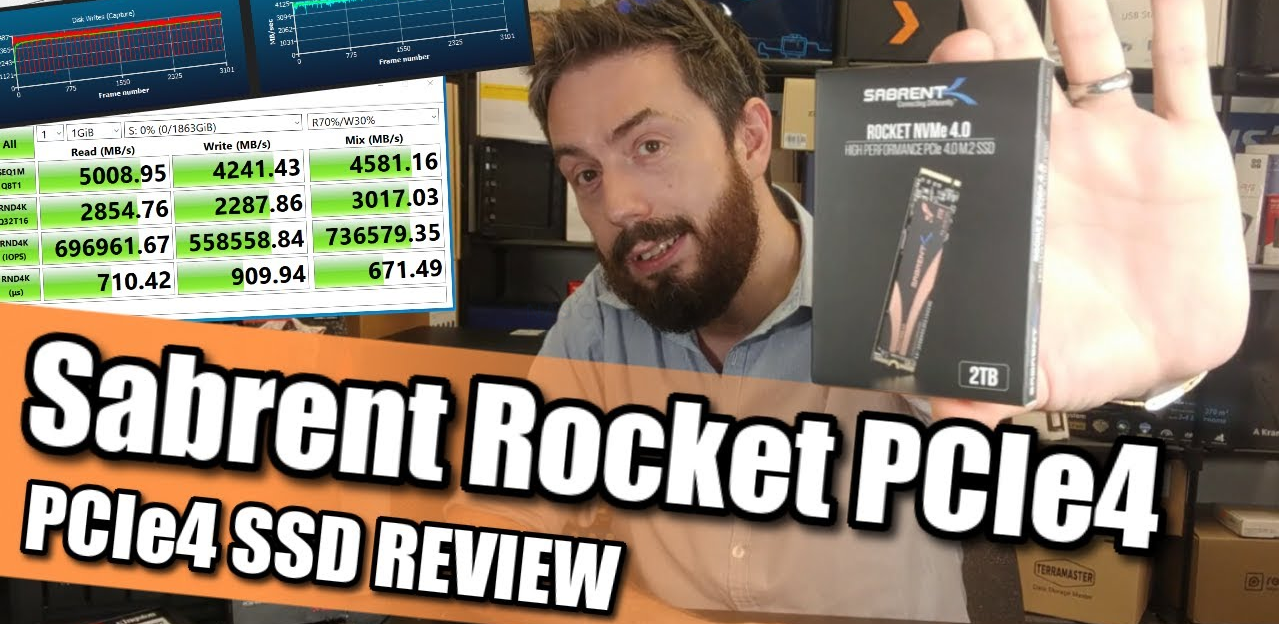
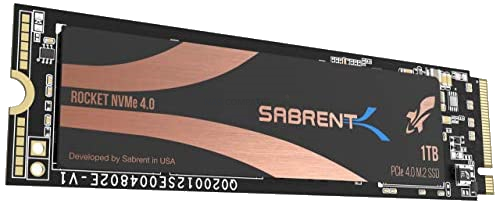






A really good & detailed video ????
REPLY ON YOUTUBE
Interesting I’m using the 2tb it’s good and the elect gears heat sinking with different venting plates on Walmart a lot different venting than D brand
REPLY ON YOUTUBE
Walmart is selling a different venting plates than D brand looks interesting
REPLY ON YOUTUBE
I had one of these in my PC and it died in a little over a year. However, sabrent did honor the warranty even though I was slightly over. I now have the replacement they sent me in my PS5 and it works just fine so far. Read speed test on the PS5 said it was just 3900MBs but it works anyways. I do have the 20 dollar sabrent PS5 heatsink on it also.
REPLY ON YOUTUBE
I have the 2tb. I’m using for the ps5 beta program still have to buy a heatsink. But I can’t wait to use it.
REPLY ON YOUTUBE
i got one for my ps5 1TB..waiting for the main update to roll out
REPLY ON YOUTUBE
Funny i just got this SSD today. Can’t wait to install it
REPLY ON YOUTUBE
Give it a rest now, you’re sucking the life out of this, some of us haven’t even been invited to the beta program, even though we’ve had 2 accounts for 25 years
REPLY ON YOUTUBE
Thanks!
REPLY ON YOUTUBE
Got one of these for my PC for $180 WITH the huge heatsink and it works like a dream and stays under 45c load and gets the full 5000MBps advertised. Love it
REPLY ON YOUTUBE
I’ve been using two of these for at least 18 months and have had no issues at all, and they are both still going strong. They’ve been great for 4K video work.
REPLY ON YOUTUBE
@4:36: And the thing about that is. Sometimes their website tool that you use to register warranty mysteriously chooses not to work. I know from personal experience.
REPLY ON YOUTUBE